It’s a case of better late than never, as Squamish sailor Paul Nilsen was able to bring his sailboat into port in Ketchikan, Alaska for the Race to Alaska, or R2AK.
Racing in the under-20-foot class, he and friend Cam Campbell left on Nilsen’s boat, Linda May, on June 22 for the 750-nautical mile (1,207 kilometre) race. They had hoped to finish in about 10 days, though Nilsen expected they might be “pinned down” a couple of extra days if they hit bad weather.
It took a little longer than expected, mostly because of low winds, and Campbell was forced to leave the race because of foot problems during one of their last chances in port to seek medical attention.
In all, it took Nilsen 23 days to complete the voyage.
“I made it. I finished 25th out of 44,” he said.
Nilsen then had to throw boat on his trailer and drive back through B.C. to get home. Even there, he hit a snag when the welding on his trailer gave out.
The wind, or lack of it, was the main culprit.
“You’re at the mercy of the winds when all you can use is oars,” he said.
The rules of the event allow the boats to use any means other than motors. On a number of occasions when he could not sail, he had to break out the oars.
“The first two days were brutal,” he said. “There was no wind.”
There were times though when the wind cooperated, which made the experience worthwhile.
“When the sailing was good, it was really enjoyable,” he said.
On top of this he saw whales and other marine life.
“I saw orcas twice. I had dolphins following me twice,” he said.
Nilsen found the couple of open ocean sections the most challenging and dangerous of the course, especially as it was a new experience for him.
“It’s the first time I’ve taken a 20-foot boat on open ocean,” he said.
He hit ground a few times and faced gale-force winds. He even found himself a little too close to the path of a cruise ship one night while sailing.
He also had some dramatic sections through which to sail, such as one fjord in which he had to make more than 300 tacks to get upwind.
“That was just a huge battle,” he said.
For food, he and Campbell existed mostly on freeze-dried food, canned goods and trail mix. They also had to bring along mosquito netting to keep away the bugs.
The boat was fitted with solar panels to keep the battery charged. As well, Linda May was equipped with a few different ways, including GPS, to find positioning.
He also had some more traditional means as back-up.
“I had paper charts the whole trip as well… in case something failed,” he said.
Sleep was at a premium in light of how little progress the boat was making.
Back home, he is now focused on resting and putting on some weight.
He said he might consider the race again, though perhaps in a different, large boat, though he has heard there is some talk the rules may change.
Still, it remains for Nilsen that he did meet his goal of being able to finish a race that many have to abandon mid-voyage.
“It’s not supposed to be a yacht race, it’s supposed to be an adventure race,” he said.




